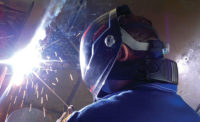Demand for U.S. industrial safety products is primarily affected by two factors: overall economic activity and employment levels; and OSHA regulatory and enforcement activity.
The U.S. market for personal protective equipment (PPE) was down approximately 20%-30% in sales volume in 2009, due to the recession and high unemployment, according to major PPE players in off-the-record conversations with For Distributors Only.
Demand for safety products in the manufacturing sector has dropped significantly. Fifty-two percent of 2010 ISHN “State of the Market” White Paper survey respondents reported declining sales and profits in 2009. Only 22% reported increased sales and profits.
Publicly-held major PPE players (MSA, Honeywell, Kimberly-Clark, DuPont, 3M) were off 20-30 percent in sales in 2009, and expect a modest recovery in sales in 2010, in the 2-5% range.
As of March, 2010, the PPE market in the U.S. is “essentially flat,” according to one major player. Growth will come in the second half of 2010 as federal stimulus dollars kick in, creating demand for safety products on construction projects and infrastructure rebuilding projects. “But we’re still waiting to see that happen,” said one PPE company executive.
At Sperian Protection, consolidated sales declined 12% for the year, the company reported, amid what it described as “a world economic crisis of unprecedented severity in 2009.”
Brice de La Morandière, chief executive officer of Sperian Protection, said in a press statement: "We expect a recovery in organic sales growth in 2010. The entire company will focus more on buoyant vertical markets, such as oil & gas, construction and electricity production and transportation, as well as on high-potential emerging countries such as China and Brazil, which will be the main growth drivers."
In February MSA announced net sales for the year ended December 31, 2009 were $910.0 million compared with $1,134.3 million in 2008, a decrease of $224.3 million, or 20 percent.
“Sales in the company's North American segment decreased $55.7 million, or 35 percent, in the fourth quarter of 2009. Self-contained breathing apparatus (SCBA) sales were down $28.6 million in the current quarter. Shipments of head protection and fall protection products were down $2.9 million and $1.8 million, respectively, as the effects of the economic recession reduced demand in construction and industrial markets. Instrument sales were $4.0 million lower in the current quarter, also due to reduced demand in industrial markets,” according to the company.
Distributors have certainly felt the after-shocks of the most severe recession since the Great Depression.
The Fastenal Company reported net sales for the three-month period ended December 31, 2009 totaled $476,750, a decrease of 12.5% from net sales of $544,959 in the fourth quarter of 2008.
Net sales for the year ended December 31, 2009 totaled $1,930,330, a decrease of 17.5% from net sales of $2,340,425 in 2008. Net earnings decreased from $279,705 in 2008 to $184,357 in 2009, a decrease of 34.1%.
Airgas, Inc., the largest U.S. distributor of industrial, medical, and specialty gases, and related supplies, reported third quarter sales were $942 million, a decline of 13% from the prior year. Total same-store sales declined 14%, with hardgoods down 19% and gas and rent down 11%.
"Although more modest than anticipated, a recovery seems to be underway across most of our geographies and customer segments," said Airgas Chairman and Chief Executive Officer Peter McCausland.
For the year ended December 31, 2009, Grainger reported sales of $6.2 billion were down 9 percent versus 2008. Net earnings of $430 million decreased 9 percent versus $475 million in 200
OSHA comes aliveOSHA, for the first time since the 1970s, is headed by three political appointees all with strong labor union ties: OSHA chief Dr. David Michaels, OSHA Deputy Jordan Barab, and OSHA chief of staff Deb Berkowitz. OSHA leadership is emphasizing to the market that “a new sheriff is in town” and large, six-figure enforcement penalties are issued now in bunches.
In addition to heavy enforcement, OSHA is in the early stages of an ambitious standards-setting process. In the next 2-3 years, standard proposals will be issued for: confined spaces in construction; combustible dust preventive measures; revised, more detailed material safety data sheets; protection against silica and beryllium exposures; and precedent-setting requirements for facility-wide safety and health programs.
The current OSHA regime is the most aggressive and ambitious the safety market has seen since the period 1976-1980, when OSHA was run by a pro-union professor under President Jimmy Carter.
How are these trends affecting safety products buyers?
OSHA compliance is job one for ISHN readers; always has been, always will be. OSHA created the modern safety profession and the market for safety products when established by Congress in 1970. The shadow cast by OSHA over the U.S. safety market is vast, historic, and beyond compare. No other market driver comes close to exerting the influence over safety product sales like OSHA does — with the exception of a historic economic recession the likes of which we saw in 2009.
According to ISHN’s 2010 State of the Market White Paper survey, here are the major job priorities for readers:
- Become more involved in corporate sustainability projects;
- Become more involved in corporate social responsibility projects;
- Contend with doing more with less: increasing work hours and increasing job stress;
- Implement more online safety training programs;
- Delegate more safety responsibilities to line employees;
- Develop measures of safety performance beyond injury “body counts” to sell top management on the “business case” for worker safety; that superior work safety performance is a competitive advantage as well as a way to keep OSHA at bay.
What will the workplace safety landscape look like in five years?
Forty-four percent U.S. safety professionals are baby boomers between ages 50-59. In the next 5-10 years, there is going to be a broad, precedent-setting turnover of safety professionals, unlike anything ever seen before.
These professionals came into their jobs 30-40 years ago, when the birth of OSHA in 1970 created industry-wide demand for middle managers with safety skills.
That hiring blitz was a one-time surge by U.S. industry. Widespread lean staffing practices, in safety departments as well as other departments, has reduced demand for safety expertise in recent decades. This has resulted in a number of university safety undergraduate programs being folded. Also, the low pay of safety jobs, between $40-$70K for most positions, has turned off many college students.
Professional societies such as the American Society of Safety Engineers and the American Industrial Hygiene Association are concerned by the lack of “new blood” entering the professional ranks, and have embarked on recruiting campaigns.
In the next 5-10 years, as veteran, long-time safety professionals retire, a good deal of their day-to-day work (training, inspections, safety observations and feedback, committee work, goal-setting, hazard identification and control, emergency response) will be assumed by line employees.
The safety staffing model of the future for mid and large-size companies will be to have one or two degreed safety pros in corporate trouble-shooting and auditing positions, also involved in sustainability and social responsibility programs; teams of trained employees will conduct routine site location activities such as inspections, observations, training, goal-setting; and the use of outside consultants and services to handle occupational health (taking the place of the traditional plant nurse); emergency response (in place of the traditional fire brigade); and chemical exposure monitoring and control (in place of the traditional industrial hygienist).
What positive things are occurring in the market now?
Positives in the safety market in 2010: greater use of technology, especially in training; greater acceptance by top management that safety can be a reputation builder and protector of brand image; and the move away from the tradition of “the safety man” toiling away in a silo, the only person at a worksite accountable for safety performance. Today, employees act as safety coaches, supervisors as safety mentors, and top managers accept greater accountability for overall safety performance.
What negative things are occurring in the market now?
The market remains too reliant on OSHA to increase product sales and create safety jobs. Too many facilities passively wait on the next OSHA standard or targeted enforcement program (on falls, lifting injuries, specific chemical exposures) before spending money.
After 40 years of existence, OSHA still has not figured out a plan for improving small business and small contractor safety. A very small federal budget for OSHA (about $550 million compared to EPA’s $13 billion) restricts OSHA’s options for reaching out to small businesses.
In addition to extremely limited federal funding, OSHA’s mission is not helped by the lack of press coverage of workplace safety hazards (say compared to media coverage of environmental issues) and the lack of worker safety champions/advocates in Congress, and also at the grassroots level.



